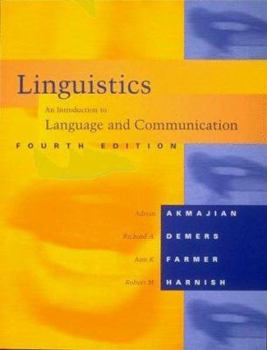Linguistics, 4th Edition: An Introduction to Language and Communication
Select Format
Select Condition 
Book Overview
The fourth edition of linguistics has been thoroughly updated and science. This is especially evident in the chapter on language acquisition, which now includes sections on the acquisition of morphology, syntax and pragmatic competence. More special topics have also been added to give teachers greater freedom to shape courses to their own interests. The basic structure of the book, however, remains unchanged, with its focus on a small set of linguistic concepts that are fundamental to the field and that will allow students to get a feel for how work in different areas of linguistics is actually done. A new and expanded third edition of the companion Linguistics Workbook adds complementary material on universal and cross-language data.
Format:Paperback
Language:English
ISBN:0262510863
ISBN13:9780262510868
Release Date:January 1995
Publisher:MIT Press (MA)
Length:577 Pages
Weight:2.45 lbs.
Dimensions:1.3" x 7.0" x 9.0"
Customer Reviews
3 ratings
Great book!
Published by Thriftbooks.com User , 16 years ago
This is a great book... I had to read it in a period of 9 weeks; and that is a lot for me, I like taking my time, but with this book I only wanted to keep going. The definitions were simple and I did not have to go back and read again because I got lost somewhere in the text.
Excellent intro text
Published by Thriftbooks.com User , 21 years ago
This is the second edition and fourth printing of this popular text by Akmajian, Demers, and Harnish at the University of Arizona. Although this text is now over 15 years old, it's still a fine introduction to the subject. One nice thing about the book is that the prose is not too technical for the beginning reader while providing excellent coverage of the important concepts and technical points. This is often a problem with linguistics texts since, unlike other technical subjects, most people have little or no background in linguistics before taking their first real course in the subject, and having previously learned a foreign language isn't as helpful as many students might think since much of linguistics, especially in the transformational grammar and generative grammar and analytical syntax areas, is a highly technical, formal, and even mathematical discipline now.As I am mainly a neuroscientist and secondarily a linguist, I was most interested in Part 3 of this book. The first two parts present the usual linguistics topics such as phonology, morphology, syntax, semantics, language variation, and evolution. Part 3 deals with the area of Psycholinguistics, and there are four chapters discussing language from the standpoint of Cognitive Psychology and Neuropsychology. The four chapters are: Pragmatics: The Study of Language Use and Communication; Speech Production and Comprehension; Language Acquisition in Chimp and Child;, and Language and the Brain. The chapter on the brain might be a little too basic for neuroscience students, but it's an excellent introduction for the linguistics students, and I noticed that a number of the classic experiments such as the famous "Wada test" and dichotic listening experiments were discussed, as well as topics like conduction aphasia, Broca's aphasia, Wernicke's aphasia, hemispheric localization and dominance, and so on. Overall still a fine text and worth picking up used if you can find it, when it will be bargain for the price.
great book for learning linguistics
Published by Thriftbooks.com User , 22 years ago
As the titele shows, this book is an intro to English linguistics. It covers almost all the fields of linguistics---morphology, phonetics, phonology, syntax, semantics, pragmatics, and sociolinguistics. In this book, there are many examples, tables, and exercises. You can learn synthetic concepts of linguistics by reading the book. English is rather easy so even the foreign people can make good use of the textbook. You can rethink about the language and communication and it will be very interesting.





